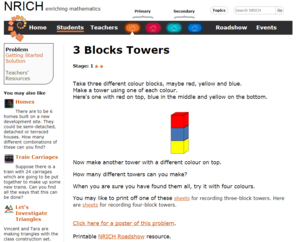Learning Path
Exploring Problem Solving with 1st and 2nd Class Learning Path
By PDST
This learning path gives a brief overview of how to develop a classroom culture of sharing knowledge, valuing mistakes and providing cognitively challenging tasks. Specific problem solving strategies can be explicitly taught using this learning path with an introduction to the concept of Low Threshold High Ceiling Tasks.
7 resources in this Learning Path
Low Threshold High Ceiling
https://nrich.maths.org/8769 Added: 26 Mar 2020 Contributor: PDST Resource type:A low threshold high ceiling task is one which is designed to be mathematically accessible, and to have built-in extension opportunities. In other words, everyone can get started and everyone can get stuck. In this updated feature, NRich brings together their favourite low threshold high ceiling tasks, as well as two articles which will support you in creating a low threshold high ceiling classroom.
View full descriptionThree Block Towers - Teacher Guide to Activity
https://nrich.maths.org/137 Added: 06 Oct 2017 Contributor: PDST Resource type:Nrich problem solving activity. Link explains the activity, provides worksheets for 3 blocks and 4 blocks challenge and a poster for the problem solving challenge.
View full descriptionHow it maps to the curriculum
- in
- Mathematics
Strand: Early Maths Activities
Strand unit: Classifying
Suggestions for use: Problem for Maths Week. Take pictures of the problem solving process and submit the PDST - Scoilnet Padlet.
Strand: Number
Strand unit: Comparing & Ordering
Content objective: This resource should enable a child to:
- use the language of ordinal number: first, last
- use the language of ordinal number: first, second, third, last
Strand: Algebra
Problem Solving For 1st and 2nd Class - Secret Number (Working Backwards)
https://nrich.maths.org/5651 Added: 26 Mar 2020 Contributor: PDST Resource type: Assessment / Game / Lesson Plan / Tool / OtherThis game is a good one to play with young children once they are familiar with the basic number operations. They will like the idea of their number being "secret", and of course being able to work out someone else's "secret" number! Looking for a ''secret'' number is the basis for algebra and solving unknowns in equations. So as well as enjoying what they are doing, your class will be engaging with some important mathematical ideas.
View full descriptionHow it maps to the curriculum
- 1-2
- Mathematics
Strand: Algebra
Suggestions for use: This can be made more difficult by applying the same rules to subtraction, multiplication and division
Problem Solving For 1st and 2nd Class - Whose Face (visualising)
https://nrich.maths.org/156 Added: 26 Mar 2020 Contributor: PDST Resource type: Assessment / Guide/notes / Lesson Plan / Tool / OtherThis problem encourages children to use logical reasoning and work systematically. It could be a good way of improving this mathematical skill without learners worrying about mathematics or numbers.
View full descriptionHow it maps to the curriculum
- 1-2
- Mathematics
Strand: Useful Websites
Suggestions for use: Develops maths skills of: Problem Solving, Reasoning, Integrating and Connecting, Communicating and Expressing, Understanding and Recalling, Implementing
Problem Solving For 1st and 2nd Class - Ring of Numbers (Conjecture)
https://nrich.maths.org/2782 Added: 26 Mar 2020 Contributor: PDST Resource type: Assessment / Guide/notes / Lesson Plan / Tool / OtherThis problem provides a context in which children can recognise odd and even numbers, and begin to think about their properties. It also offers practice in addition and subtraction.
View full descriptionHow it maps to the curriculum
- 1-2
- Mathematics
Strand: Number
Strand unit: Operation: Addition
Suggestions for use: Also can be used for subtraction
Problem Solving For 1st and 2nd Class- Domino Join Up (Trial and Improvement)
https://nrich.maths.org/245 Added: 26 Mar 2020 Contributor: PDST Resource type: Assessment / Game / Lesson Plan / ToolThis problem is useful for providing an interesting way of practising simple addition and subtraction. It can also be used to learn more about the rules for adding odd and even numbers. The problem requires a trial and improvement approach, and it is worthwile encouraging learners to articulate their method, so that it can be compared with someone else's.
View full descriptionHow it maps to the curriculum
- 1-2
- Mathematics
Strand: Number
Strand unit: Counting & Numeration
Content objective: This resource should enable a child to:
- read, write and order numerals, 0-99
Problem Solving For 1st and 2nd - Turning Man (Visualising)
https://nrich.maths.org/5560 Added: 26 Mar 2020 Contributor: PDST Resource type: Assessment / Lesson Plan / Tool / OtherThis problem is intended to help children who are confident about turning themselves a quarter or half turn, but find it difficult to relate this to quarter or half turns in a picture or diagram. The Turning Man is a "halfway house" between these two.
View full descriptionHow it maps to the curriculum
- 1-2
- Mathematics
Strand: Shape & Space
Strand unit: Spatial Awareness
Content objective: This resource should enable a child to:
- explore, discuss, develop and use the vocabulary of spatial relations
- give and follow simple directions within classroom and school settings, including turning directions using half and quarter turns

